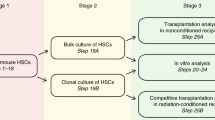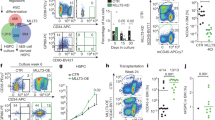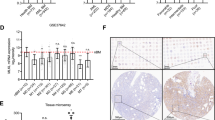Abstract
Embryonic stem (ES) cells, the totipotent outgrowths of bias-tocysts1,2, can be cultured and manipulated in vitro and then returned to the embryonic environment where they develop normally and can contribute to all cell lineages3–9. Maintenance of the stem-cell phenotype in vitro requires the presence of a feeder layer of fibroblasts1,2,10 or of a soluble factor, differentiation inhibitory activity (DIA) produced by a number of sources5,11,12; in the absence of DIA the ES cells differentiate into a wide variety of cell types. We recently noted several similarities between partially purified DIA and a haemopoietic regulator, myeloid leukaemia inhibitory factor (LIF), a molecule which induces differentiation in Ml myeloid leukaemic cells and which we have recently purified, cloned and characterized13–18. We demonstrate here that purified, recombinant LIF can substitute for DIA in the maintenance of totipotent ES cell lines that retain the potential to form chimaeric mice.
This is a preview of subscription content, access via your institution
Access options
Subscribe to this journal
Receive 51 print issues and online access
$199.00 per year
only $3.90 per issue
Buy this article
- Purchase on Springer Link
- Instant access to full article PDF
Prices may be subject to local taxes which are calculated during checkout
Similar content being viewed by others
References
Evans, M. J. & Kaufman, M. H. Nature 292, 154–156 (1981).
Martin, G. R. Proc. natn. Acad. Sci. U.S.A. 78, 7634–7638 (1981).
Bradley, A., Evans, M., Kaufman, M. H. & Robertson, E. Nature 309, 255–256 (1984).
Robertson, E. J., Bradley, A., Kuehn, M. & Evans, M. Nature 323, 445–448 (1986).
Hooper, M., Hardy, K., Handyside, A., Hunter, S. & Monk, M. Nature 326, 292–295 (1987).
Kuehn, M. R., Bradley, A., Robertson, E. J. & Evans, M. J. Nature 326, 295–298 (1987).
Williams, R. L., Courtneidge, S. A. & Wagner, E. F. Cell 52, 121–131 (1988).
Stewart, C. L., Vanek, M. & Wagner, E. F. EMBO J. 4, 383–388 (1985).
Gossler, A., Doetschmann, T., Korn, R., Serfling, E. & Kemler, R. Proc. natn. Acad. Sci. U.S.A. 83, 9065–9069 (1986).
Martin, G. R. & Evans, M. J. Proc. natn. Acad. Sci. U.S.A. 72, 1441–1445 (1975).
Smith, A. G. & Hooper, M. L. Devl Biol. 121, 1–9 (1987).
Koopman, P. & Cotton, R. G. H. Exptl Cell Res. 154, 233–242 (1984).
Gearing, D. P. et al. EMBO J. 6, 3995–4002 (1987).
Gough, N. M. et al. Proc. natn. Acad. Sci. U.S.A. 85, 2623–2627 (1988).
Hilton, D. J., Nicola, N. A., Gough, N. M. & Metcalf, D. J. biol. Chem. 263, 9238–9443 (1988).
Metcalf, D., Hilton, D. J. & Nicola, N. A. Leukaemia 2, 216–221 (1988).
Hilton, D. J., Nicola, N. A. & Metcalf, D. Analyt. Biochem. 173, 359–367 (1988).
Simpson, R. J. et al. Eur. J. Biochem. 175, 541–547 (1988).
Hilton, D. J., Nicola, N. A. & Metcalf, D. Proc. natn. Acad. Sci. U.S.A. 85, 5971–5975 (1988).
Wagner, E. F., Keller, G., Gilboa, E., Rüther, U. & Stewart, C. Cold Spring Harb. Symp. quant. Biol. 50, 691–700 (1985).
Jakob, J., Bonn, T., Gaillard, J., Nicolas, J. F. & Jacob, F. Ann. Microbiol. (Inst. Pasteur) 124B, 269–282 (1973).
Rudnicki, M. A. & McBurney, M. W. in Teratocarcinomas and Embryonic Stem Cells, a Practical Approach (ed. E. J. Robertson) 19–49 (IRL, Oxford, 1987).
Doetschman, T., Eistetter, H., Katz, M., Schmidt, W. & Kemler, R. J. Embryol. exp. Morphol. 87, 27–45 (1985).
Dewey, M. J., Martin, D. W., Martin, G. R. & Mintz, B. Proc. natn. Acad. Sci. U.S.A. 74, 5564–5568 (1977).
Kemler, R. in Progress in Developmental Biology Band 26 (ed. Sauer, H. W.) 175 (Fisher, Stuttgart, 1980).
Thomas, K. R. & Capecchi, M. R. Cell 51, 503–512 (1987).
Doetschman, T. et al. Nature 330, 576–577 (1987).
Munson, P. J. & Rodbard, D. Analyt. Biochem. 107, 220–237 (1980).
Nicola, N. A. & Metcalf, D. J. cell. Physiol. 124, 313–321 (1985).
Smith, D. B. & Johnson, K. S. Gene 67, 31–40 (1988).
Smith, A. G. et al. Nature 336, 688–690 (1988).
Author information
Authors and Affiliations
Rights and permissions
About this article
Cite this article
Williams, R., Hilton, D., Pease, S. et al. Myeloid leukaemia inhibitory factor maintains the developmental potential of embryonic stem cells. Nature 336, 684–687 (1988). https://doi.org/10.1038/336684a0
Received:
Accepted:
Issue Date:
DOI: https://doi.org/10.1038/336684a0
This article is cited by
-
Dynamic nucleolar phase separation influenced by non-canonical function of LIN28A instructs pluripotent stem cell fate decisions
Nature Communications (2024)
-
Rhox6 regulates the expression of distinct target genes to mediate mouse PGCLC formation and ESC self-renewal
Cell & Bioscience (2023)
-
A multi-omics integrative analysis based on CRISPR screens re-defines the pluripotency regulatory network in ESCs
Communications Biology (2023)
-
Bone Marrow Mesenchymal Stem Cells Expanded Inside the Nichoid Micro-Scaffold: a Focus on Anti-Inflammatory Response
Regenerative Engineering and Translational Medicine (2023)
-
Classes of Stem Cells: From Biology to Engineering
Regenerative Engineering and Translational Medicine (2023)
Comments
By submitting a comment you agree to abide by our Terms and Community Guidelines. If you find something abusive or that does not comply with our terms or guidelines please flag it as inappropriate.



